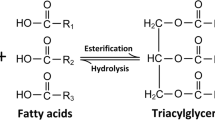Abstract
Bio-oil resulting from the pyrolysis of lignocellulose is a complex mixture of polar low molecular mass oxygenated compounds of various functionalities and non-polar high molecular mass lignin derivatives. Several approaches to the upgrading of bio-oil are currently in progress. This study investigates the valorisation of crude bio-oil using physical and chemical methods. The effects of methanol addition on some properties of the bio-oil are investigated. Stable bio-oil/diesel oil emulsions are produced by the addition of surfactants with a hydrophilic-lipophilic balance value of 5–6. An alternative approach towards the upgrading of bio-oil is the hydrotreatment of the water-soluble fraction of bio-oil. Two-stage hydroprocessing with noble-metal catalysts Ru/C and Pt/C increases the intrinsic hydrogen content of the water-soluble fraction. The results show that the thermally unstable components including sugars, ketones and aldehydes are readily converted to diols and alcohols at pressures of 5 MPa. These observations can be explained by a set of reaction pathways for the compounds identified.
Similar content being viewed by others
References
Adjaye, J. D., & Bakhshi, N. N. (1995a). Catalytic conversion of a biomass-derived oil to fuels and chemicals I: Model compound studies and reaction pathways. Biomass and Bioenergy, 8, 131–149. DOI: 10.1016/0961-9534(95)00018-3.
Adjaye, J. D., & Bakhshi, N. N. (1995b). Catalytic conversion of a biomass-derived oil to fuels and chemicals II: Chemical kinetics, parameter estimation and model predictions. Biomass and Bioenergy, 8, 265–277. DOI: 10.1016/0961-9534(95)00019-4.
American Society for Testing and Materials (2008). Standard test method for water using Karl Fischer titration. E203-08. West Conshocken, PA, USA. DOI: 10.1520/e0203-08.
American Society for Testing and Materials (2012). Standard test method for kinematic viscosity of transparent and opaque liquids. D445-12. West Conshocken, PA, USA. DOI: 10.1520/d0445-12.
Bridgwater, A., Czernik, S., Diebold, J., Meier, D., Oasmaa, A., Peacocke, C., Piskorz, J., & Radlein, D. (1999). Fast pyrolysis of biomass: a handbook. Thatcham, UK: CPL Press.
Bridgwater, A. V., & Peacocke, G. V. C. (2000). Fast pyrolysis processes for biomass. Renewable and Sustainable Energy Reviews, 4, 1–73. DOI: 10.1016/s1364-0321(99)00007-6.
Chiaramonti, D., Bonini, M., Fratini, E., Tondi, G., Gartner, K., Bridgwater, A. V., Grimm, H. P., Soldaini, I., Webster, A., & Baglioni, P. (2003). Development of emulsions from biomass pyrolysis liquids and diesel and their use in engines-Part 1: emulsion production. Biomass and Bioenergy, 25, 85–99. DOI: 10.1016/s0961-9534(02)00183-6.
Czernik, S., Johnson, D. K., & Black, S. (1994). Stability of wood fast pyrolysis oil. Biomass and Bioenergy, 7, 187–192. DOI: 10.1016/0961-9534(94)00058-2.
Davda, R. R., Shabaker, J. W., Huber, G. W., Cortright, R. D., & Dumesic, J. A. (2003). Aqueous-phase reforming of ethylene glycol on silica-supported metal catalysts. Applied Catalysis B: Environmental, 43, 13–26. DOI: 10.1016/s0926-3373(02)00277-1.
Demirbas, A. (2004). Current technologies for thermo-conversion of biomass into fuels and chemicals. Energy Sources, 26, 715–730. DOI: 10.1080/00908310490445562.
Diebold, J. P., & Czernik, S. (1997). Additives to lower and stabilize the viscosity of pyrolysis oils during storage. Energy & Fuels, 11, 1081–1091. DOI: 10.1021/ef9700339.
Elliot, D. C. (2007). Historical developments in hydroprocessing bio-oils. Energy & Fuels, 21, 1792–1815. DOI: 10.1021/ef070044u.
Elliot, D. C., Hart, T. R., Neuenschwander, G. G., Rotness, L. J., & Zacher, A. H. (2009). Catalytic hydroprocessing of biomass fast pyrolysis bio-oil to produce hydrocarbon products. Environmental Progress & Sustainable Energy, 28, 441–449. DOI: 10.1002/ep.10384.
Furimsky, E. (2013). Hydroprocessing challenges in biofuel production. Catalysis Today, 217, 13–56. DOI: 10.1016/j.cattod.2012.11.008.
Huber, G. W., Cortright, R. D., & Dumesic, J. A. (2004). Renewable alkanes by aqueous-phase reforming of biomassderived oxygenates. Angewandte Chemie International Edition, 43, 1549–1551. DOI: 10.1002/anie.200353050.
Ikura, M., Mirmiran, S., Sawatzky, H., & Stanciulescu, M. (1998). U.S. Patent No. 5820640 A. Washington, D.C., USA: U.S. Patent and Trademark Office.
Oasmaa, A., & Kuoppala, E. (2003). Fast pyrolysis of forestry residue. 3. Storage stability of liquid fuel. Energy & Fuels, 17, 1075–1084. DOI: 10.1021/ef030011o.
Oasmaa, A., & Peacocke, C. (2010). Properties and fuel use of biomass-derived fast pyrolysis liquids. Vuorimiehentie, Finland: VTT.
Oasmaa, A., Kuoppala, E., Ardiyanti, A., Venderbosch, R. H., & Heeres, H. J. (2010). Characterization of hydrotreated fast pyrolysis liquids. Energy & Fuels, 24, 5264–5272. DOI: 10.1021/ef100573q.
Lu, Q., Yang, X. L., & Zhu, X. F. (2008). Analysis on chemical and physical properties of bio-oil pyrolized from rice husk. Journal of Analytical and Applied Pyrolysis, 82, 191–198. DOI: 10.1016/j.jaap.2008.03.003.
Venderbosch, R. H., & Prins, W. (2010). Fast pyrolysis technology development. Biofuels, Bioproducts and Biorefining, 4, 178–208. DOI: 10.1002/bbb.205.
Vispute, T. P., Zhang, H. Y., Sanna, A., Xiao, R., & Huber, G. W. (2010). Renewable chemical commodity feedstocks from integrated catalytic processing of pyrolysis oils. Science, 330, 1222–1227. DOI: 10.1126/science.1194218.
Wildschut, J., Arentz, J., Rasrendra, C. B., Venderbosch, R. H., & Heeres, H. J. (2009). Catalytic hydrotreatment of fast pyrolysis oil: Model studies on reaction pathways for the carbohydrate fraction. Environmental Progress & Sustainable Energy, 28, 450–460. DOI: 10.1002/ep.10390.
Author information
Authors and Affiliations
Corresponding author
Rights and permissions
About this article
Cite this article
Vanderauwera, P.F.L.P., Wambeke, D.M.C. Valorisation of bio-oil resulting from fast pyrolysis of wood. Chem. Pap. 68, 1205–1212 (2014). https://doi.org/10.2478/s11696-014-0541-y
Received:
Revised:
Accepted:
Published:
Issue Date:
DOI: https://doi.org/10.2478/s11696-014-0541-y




